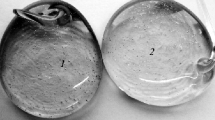Abstract
The possibility of using available Ukrainian raw materials for the production of glass high-voltage insulators is studied. The introduction of the developed low-alkaline glass made it possible to reduce the cost of the products and the consumption of power in glass melting, improve the working conditions, and decrease the pollution of the atmosphere due to elimination of fluorine from the composition of the glass.
Similar content being viewed by others
References
T. D. Andryukhina, E. I. Raevskaya, É. I. Sanina, et al., “Chemical compositions of commercial glasses,” in:Inf. Rev. VNIIÉSM, Iss. 2 (1986).
P. D. Sarkisov and A. S. Agarkov,Technical Analysis and Control over the Production of Glass and Glass Articles [in Russian], Stroiizdat, Moscow (1976).
Additional information
Translated from Steklo i Keramika, No. 10, pp. 5–7, October, 1996.
High Voltage Research Institute.
Rights and permissions
About this article
Cite this article
Soboleva, K.L., Gusak, N.Y., Mukhin, V.P. et al. Use of ukrainian raw materials in the production of electric insulating glasses. Glass Ceram 53, 289–292 (1996). https://doi.org/10.1007/BF01130792
Issue Date:
DOI: https://doi.org/10.1007/BF01130792




